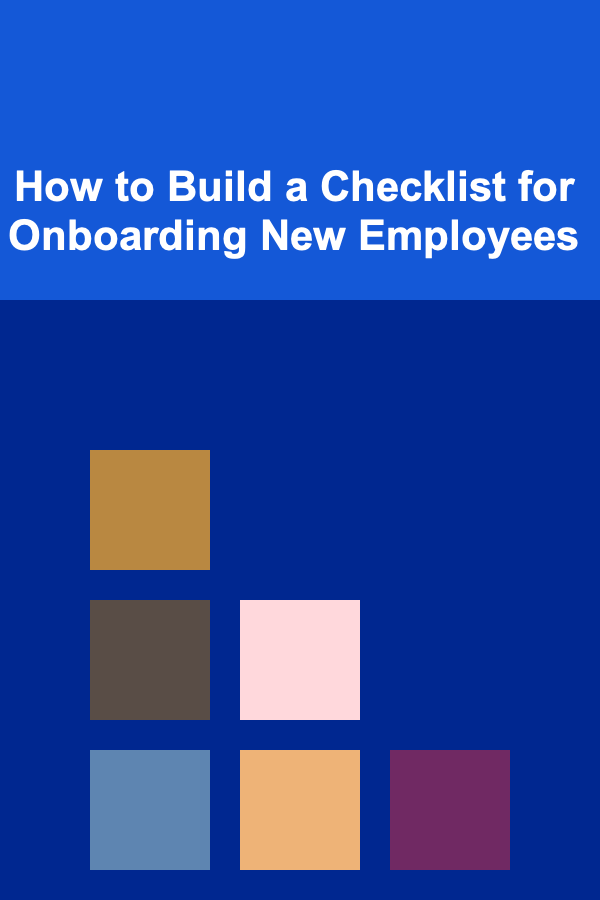
How to Build a Checklist for Onboarding New Employees
ebook include PDF & Audio bundle (Micro Guide)
$12.99$7.99
Limited Time Offer! Order within the next:

Onboarding is one of the most critical phases in an employee's journey at your company. A well-executed onboarding process sets the tone for the employee's experience, helps them feel welcomed, and prepares them for success in their new role. One of the most effective ways to ensure a smooth and successful onboarding process is by creating a comprehensive checklist. This guide will walk you through the steps of building an effective checklist for onboarding new employees that promotes engagement, productivity, and long-term retention.
Pre-Onboarding: Setting the Stage Before Day One
The first step to a successful onboarding experience is to ensure that new hires are set up for success even before their first day. Pre-onboarding helps reduce first-day jitters and gives the new employee a sense of anticipation and excitement.
What to Include in Pre-Onboarding:
- Welcome Package: Send out a welcome email or physical package that includes company swag, a personalized note, and any necessary documents they may need for their first day. This could include an employee handbook, IT policies, or benefits information.
- Administrative Setup: Ensure that IT has prepared the necessary hardware (laptop, phone, etc.) and software (email accounts, access to necessary tools) for the new employee. This should be ready before the first day.
- Access to Systems: Provide the new hire with access to important systems and platforms, such as HR software, communication tools, and any internal resources they'll need to hit the ground running.
- Pre-Work Assignments: If relevant, send them a brief overview of the company culture, the team they'll be working with, and the objectives for their first few weeks. You might also include an initial reading list, training modules, or videos to help them familiarize themselves with your organization's practices.
Actionable Tip:
Create a pre-onboarding checklist template that includes all the items you want to address before the employee's first day. Automating this process using HR software can save time and ensure consistency.
First Day: Setting a Positive Tone
The first day of onboarding is crucial. It's the first time the new employee experiences your company culture, and how you structure their first day can have a lasting impact. The goal is to make the new hire feel welcomed, valued, and informed.
What to Include on Day One:
- Introduction to the Team: Have a team meeting where the new employee is introduced to key colleagues. This could be done via video call or in person. Introduce them to direct team members, managers, and support staff they will be working closely with.
- Office Tour (if applicable): If the employee is in the office, give them a tour of the workspace. Show them important areas like the break room, restrooms, emergency exits, and where important office supplies are located.
- IT Setup: Walk them through setting up their workstation, including email accounts, software systems, phone systems, and any other necessary tools or platforms. Ensure they are set up to communicate with their team effectively from day one.
- Company Culture Overview: Provide an introduction to your company's mission, values, and culture. This could include a presentation, a video, or an informal meeting with a senior leader who can discuss the company's vision and how the new hire fits into it.
- Policies and Compliance: Go over important policies (e.g., work hours, dress code, remote work guidelines, and safety protocols). Make sure the new employee is aware of and has signed off on any compliance-related documentation.
Actionable Tip:
Prepare a specific "first-day" schedule for each department. This helps both the employee and the team understand what will be covered and ensures nothing is missed.
Week One: Deepening Engagement and Training
The first week sets the stage for deeper integration into the company. It's important to ensure that the employee understands their role, feels comfortable with their colleagues, and begins to engage in the learning process.
What to Include in Week One:
- Role-Specific Training: Offer structured training that is specific to the employee's job. This might include software tutorials, process walk-throughs, or shadowing a team member. Ensure that they understand the core responsibilities and performance expectations.
- Meetings with Key Stakeholders: Set up one-on-one meetings with key team members and other departments that the new employee will interact with. This provides them with a holistic view of the company's operations and allows them to start building relationships.
- Feedback Sessions: Have regular check-ins throughout the first week to see how the new hire is adjusting. These can be informal but should focus on answering questions, providing clarification, and ensuring that they have the tools and resources they need to succeed.
- Mentor/Buddy Program: Pair the new hire with a mentor or buddy who can provide guidance and support. This person can help with day-to-day questions and ease the employee into your company's culture.
- Task Assignments: Give them small, manageable tasks to start applying what they've learned in training. These tasks should help build their confidence and demonstrate progress.
Actionable Tip:
Use a combination of in-person meetings, virtual check-ins, and online training resources to ensure a balance between learning, collaboration, and getting up to speed quickly.
Month One: Expanding Responsibilities and Performance Goals
The first month is where the new employee begins to take on more responsibilities and starts contributing to the team. They should also begin to understand their individual performance goals and how their role fits into the company's broader objectives.
What to Include in Month One:
- Continued Training and Development: Depending on the complexity of the role, training should continue into the first month. This could include advanced training sessions, certifications, or learning new tools relevant to their position.
- Performance Check-In: Schedule a formal check-in with the new hire's direct manager to discuss their progress. This includes setting performance expectations, identifying areas for growth, and addressing any concerns. Establishing goals at this stage is key to employee motivation.
- Team Integration: Ensure that the new hire continues to build relationships within the team. Assign collaborative projects or pair them with a colleague for a cross-functional task. Encourage social interactions, whether in person or virtually, to foster a sense of belonging.
- Feedback Mechanism: Continue providing constructive feedback on the employee's performance and any challenges they may be facing. Create an open space for them to provide feedback on their onboarding experience and suggest areas for improvement.
- Involvement in Company Activities: Get the new employee involved in company-wide events, team lunches, or other social activities. This helps them feel like part of the larger company culture.
Actionable Tip:
Make performance reviews at the end of the first month a two-way conversation. Not only should managers provide feedback, but employees should also have the chance to share their experiences and feedback on the onboarding process.
Ongoing Support: Building Long-Term Success
Onboarding doesn't end after the first month. Continuous support is necessary to ensure the new employee feels engaged, valued, and aligned with their role and company goals.
What to Include in Ongoing Support:
- Regular Check-Ins: Continue with regular one-on-one check-ins with the manager. These meetings can transition from being performance-focused to more about long-term career development and goals.
- Professional Development: Encourage participation in training programs, workshops, or industry conferences. Providing opportunities for growth shows that the company values employee development.
- Peer Feedback: Once the employee is settled into their role, seek feedback from their colleagues about how they're integrating into the team. This helps identify potential issues that the employee might not have raised.
- Recognition and Rewards: Acknowledge achievements, both small and large. Recognition can come in various forms, such as verbal praise, awards, or bonuses, which motivates the employee and fosters a positive working environment.
Actionable Tip:
Create a roadmap for each employee's growth and development within the company. Provide regular feedback and encourage them to set personal and professional goals that align with company objectives.
Conclusion
Building an effective checklist for onboarding new employees ensures that your organization provides a seamless and welcoming experience. A structured onboarding process can lead to higher employee engagement, improved retention rates, and faster time-to-productivity. By preparing in advance, setting clear expectations, providing continuous support, and fostering a culture of feedback, you create a strong foundation for long-term success for both the new employee and your company.
Reading More From Our Other Websites
- [Organization Tip 101] How to Create a Tenant Handbook for Clear Communication
- [Beachcombing Tip 101] Eco-Friendly Beachcombing: Sustainable Practices to Preserve Marine Life While Hunting for Gems
- [Home Soundproofing 101] How to Choose Professional Soundproofing Services for Maximum Results
- [Home Security 101] How to Leverage Xfinity Home Features for Comprehensive Home Security
- [Personal Care Tips 101] How to Choose a Concealer That Won't Clog Pores
- [Personal Investment 101] How to Invest in Bonds for Steady Income
- [Home Holiday Decoration 101] How to Make a Statement with Your Holiday Dining Room Decor
- [Personal Care Tips 101] How to Choose a Razor for a Pain-Free Shaving Experience
- [Organization Tip 101] How to Organize Your Sewing Room for Seasonal Projects
- [Tie-Dyeing Tip 101] Mastering the Shibori "Kanoko" Method for Subtle Tie‑Dye Effects on Cotton

How to Create a Virtual Workspace that Reduces Distractions
Read More
How to Organize Your Digital Files to Avoid Confusion
Read More
How to Sell Your Rare Coins on eBay: An Actionable Guide
Read More
How to Understand Basic Strength Training Principles
Read More
How To Grasp the Concepts of Oracles in Smart Contracts
Read More
How to Explore Beyond Our Solar System
Read MoreOther Products

How to Create a Virtual Workspace that Reduces Distractions
Read More
How to Organize Your Digital Files to Avoid Confusion
Read More
How to Sell Your Rare Coins on eBay: An Actionable Guide
Read More
How to Understand Basic Strength Training Principles
Read More
How To Grasp the Concepts of Oracles in Smart Contracts
Read More